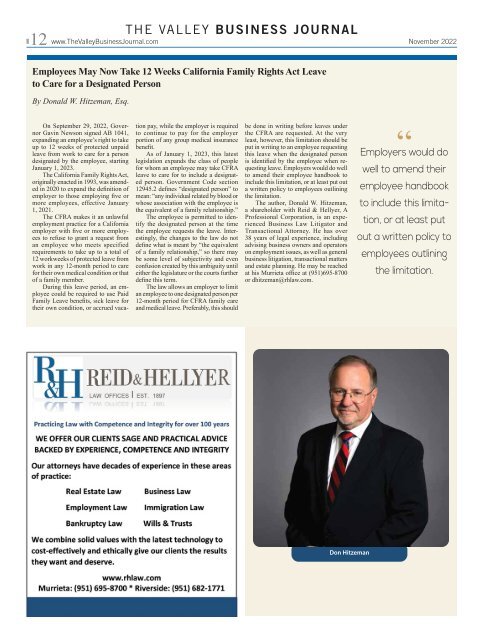Create successful ePaper yourself
Turn your PDF publications into a flip-book with our unique Google optimized e-Paper software.
THE VALLEY BUSINESS JOURNAL<br />
12 www.TheValleyBusinessJournal.com<br />
<strong>November</strong> 20<strong>22</strong><br />
Employees May Now Take 12 Weeks California Family Rights Act Leave<br />
to Care for a Designated Person<br />
By Donald W. Hitzeman, Esq.<br />
On September 29, 20<strong>22</strong>, Governor<br />
Gavin Newson signed AB 1041,<br />
expanding an employee’s right to take<br />
up to 12 weeks of protected unpaid<br />
leave from work to care for a person<br />
designated by the employee, starting<br />
January 1, 2023.<br />
The California Family Rights Act,<br />
originally enacted in 1993, was amended<br />
in 2020 to expand the definition of<br />
employer to those employing five or<br />
more employees, effective January<br />
1, 2021.<br />
The CFRA makes it an unlawful<br />
employment practice for a California<br />
employer with five or more employees<br />
to refuse to grant a request from<br />
an employee who meets specified<br />
requirements to take up to a total of<br />
12 workweeks of protected leave from<br />
work in any 12-month period to care<br />
for their own medical condition or that<br />
of a family member.<br />
During this leave period, an employee<br />
could be required to use Paid<br />
Family Leave benefits, sick leave for<br />
their own condition, or accrued vacation<br />
pay, while the employer is required<br />
to continue to pay for the employer<br />
portion of any group medical insurance<br />
benefit.<br />
As of January 1, 2023, this latest<br />
legislation expands the class of people<br />
for whom an employee may take CFRA<br />
leave to care for to include a designated<br />
person. Government Code section<br />
12945.2 defines “designated person” to<br />
mean: “any individual related by blood or<br />
whose association with the employee is<br />
the equivalent of a family relationship.”<br />
The employee is permitted to identify<br />
the designated person at the time<br />
the employee requests the leave. Interestingly,<br />
the changes to the law do not<br />
define what is meant by “the equivalent<br />
of a family relationship,” so there may<br />
be some level of subjectivity and even<br />
confusion created by this ambiguity until<br />
either the legislature or the courts further<br />
define this term.<br />
The law allows an employer to limit<br />
an employee to one designated person per<br />
12-month period for CFRA family care<br />
and medical leave. Preferably, this should<br />
be done in writing before leaves under<br />
the CFRA are requested. At the very<br />
least, however, this limitation should be<br />
put in writing to an employee requesting<br />
this leave when the designated person<br />
is identified by the employee when requesting<br />
leave. Employers would do well<br />
to amend their employee handbook to<br />
include this limitation, or at least put out<br />
a written policy to employees outlining<br />
the limitation.<br />
The author, Donald W. Hitzeman,<br />
a shareholder with Reid & Hellyer, A<br />
Professional Corporation, is an experienced<br />
Business Law Litigator and<br />
Transactional Attorney. He has over<br />
38 years of legal experience, including<br />
advising business owners and operators<br />
on employment issues, as well as general<br />
business litigation, transactional matters<br />
and estate planning. He may be reached<br />
at his Murrieta office at (951)695-8700<br />
or dhitzeman@rhlaw.com.<br />
“<br />
Employers would do<br />
well to amend their<br />
employee handbook<br />
to include this limitation,<br />
or at least put<br />
out a written policy to<br />
employees outlining<br />
the limitation.<br />
Don Hitzeman
















